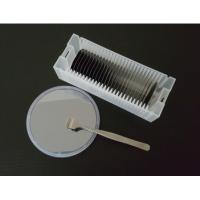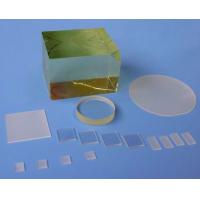Indium Phosphide Wafer InP Semiconductor Substrates Epitaxial 2''
3'' Thickness 350um
Description of Indium Phosphide:
Indium Phosphide (InP) chips are a widely used material in
optoelectronics and semiconductor devices. It has the following
advantages:
- High electron mobility: Indium phosphide chips have a high electron
mobility, which means that electrons move faster through the
material.
- Controlled material properties: The properties of indium phosphide
wafers can be regulated by controlling the epitaxial growth process
of the material and doping techniques.
- Wide band gap: The indium phosphide wafer has a wide band gap,
enabling it to operate in the visible and infrared light ranges.
- High saturation drift speed: The indium phosphide wafer has a high
saturation drift speed, which means that the electron drift speed
reaches the maximum under a high electric field.
- Excellent thermal conductivity: The indium phosphide wafer has a
high thermal conductivity, which means that it is able to
efficiently conduct and dissipate heat, thereby improving the
reliability and performance stability of the device.
Features of Indium Phosphide:
Indium Phosphide (InP) chips have some remarkable characteristics
that make them widely used in optoelectronics and semiconductors.
The following are some of the main characteristics of indium
phosphide chip materials:
- Direct band gap: Indium phosphide has a direct band gap
characteristic that makes it excellent in optical devices.
- Wide band gap range: Indium phosphide has a wide band gap ranging
from infrared to ultraviolet spectrum.
- High electron mobility: Indium phosphide has a high electron
mobility, which makes it excellent in high-frequency electronics
and high-speed optoelectronics.
- Excellent thermal conductivity: Indium phosphide has a high thermal
conductivity and can effectively dissipate heat.
- Good mechanical and chemical stability: Indium phosphide chips have
good mechanical and chemical stability and can maintain stability
and reliability under different environmental conditions.
- Adjustable band structure: The band structure of indium phosphide
materials can be regulated by doping and alloying techniques to
meet the requirements of different devices.
Technical Parameters of Indium Phosphide:
Item | Parameter | UOM |
Material | InP |
|
Conduction type/Dopant | S-C-N/S |
|
Grade | Dummy |
|
Diameter | 100.0+/-0.3 | mm |
Orientation | (100) +/-0.5° |
|
Lamellar twin area | useful single crystal area with (100) orienation > 80% |
|
Primary Flat Orientation | EJ(0-1-1) | mm |
Primary Flat Length | 32.5+/-1 |
|
Secondary Flat Orientation | EJ(0-11) |
|
Secondary Flat Length | 18+/-1 |
|
Applications of Indium Phosphide:
Indium Phosphide (InP) wafers have a wide range of applications in
optoelectronics and semiconductor substrates:
- Optical communication: InP wafers are widely used in the field of
optical communication for high-speed optical fiber communication
systems. They are used to fabricate devices such as lasers, optical
modulators, optical receivers, optical amplifiers and optical fiber
couplers.
- Photoelectronic devices: InP wafers are used to make
photoelectronic devices such as photodiodes, photodetectors, solar
cells and photocouplers.
- High-speed electronic devices: InP substrates are widely used in
the field of high-frequency electronic devices. In particular, InP
wafes' high electron mobility transistors (HEMTs) are used to
prepare devices such as high-frequency amplifiers, RF switches and
microwave integrated circuits for applications such as wireless
communications, radar systems and satellite communications.
- Integrated optical devices: InP wafers are used to prepare
integrated optical devices such as optical waveguides, optical
modulators, optical switches and optical amplifiers.
- Photonics research: InP wafers play an important role in photonics
research. They are used in laboratory research, quantum optics,
quantum information processing and optical quantum devices.
- In addition to the above applications, InP wafers are also used in
other fields, such as optical sensing, biomedicine, light storage
and semiconductor substrates

FAQ:
Q1: What brand name is the InP wafer?
A1: The InP wafer is made by ZMSH.
Q2: What's the diameter of the InP wafer?
A2: The diameter of InP wafer is 2'', 3'', 4''.
Q3: Where is the InP wafer from?
A3: The InP wafer is from China.
Q4: Is the InP wafer ROHS certified?
A4: Yes, the InP wafer is ROHS certified.
Q5: How many InP wafes can I buy at 1 time?
A5: The minimum order quantity of the InP wafer is 5pcs.
Other products:
Silicon
wafers







